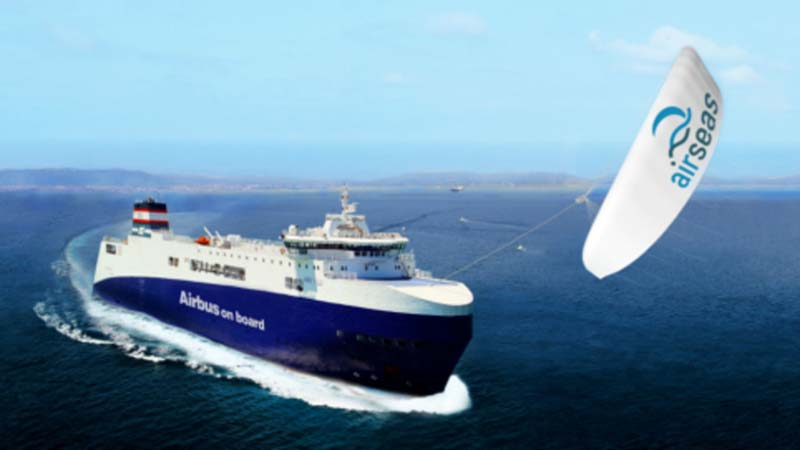
Illustration of an Airseas kite towing the Ville de Bordeaux (Airseas)
The global maritime industry is forecast to see more prosperity in 2022. Wind-harvesting sails, kites, wings and tubes that aim to reduce the use of diesel fuel in generating ship propulsion are on the rise. deployed to begin use on cargo ships. Nearly two dozen wind projects are underway, experts say, as shipping companies find ways to limit emissions from ocean freight.
The first thing to mention is the kite technology of Airseas - a French startup founded by former Airbus aeronautical engineers. Starting in January 2022, Airseas first deployed the automated Seawing system on cargo ships. The blue-and-white Ville de Bordeaux will raise a 500-square-foot kite during six months of sea trials. Airbus has ordered a kite for this ship to carry parts of an aircraft traveling between France and the United States.
Airseas installed the Seawing system in December 2021 in front of the 152-meter Ville de Bordeaux. Just turn on the switch, the kite will automatically inflate and position itself in the wind, helping to tow the boat and reduce the workload of the main engine, helping to save fuel. Sensors attached to the kite's tether collect weather data to optimize the system's performance. When the tug is no longer needed, the leash retracts and the kite folds back into the bow.
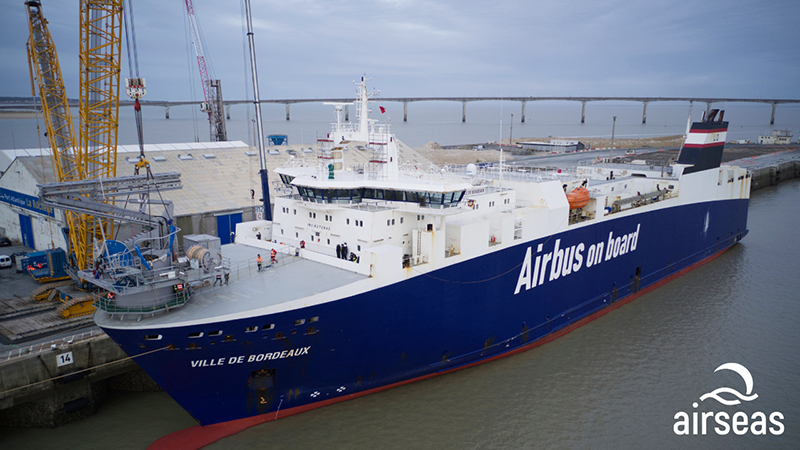
Kite racks being installed for the Ville de Bordeaux
The Seawing will operate without crew intervention on board, although a team of 10 employees from Airseas will be on board to test and fine-tune the system during testing. Airseas already has another big customer lined up if all goes well. Japanese ship owner K Line has placed two orders for the kite version with an area of 1,000 square meters with a range of more than 300 meters in the air.
Airseas estimates the larger kite will reduce the ship's fuel consumption and associated emissions by an average of 20%.
A quick solution to air-polluting ships
Shipping companies worldwide are facing increasing pressure from regulators, charterers and consumers to tackle the industry's massive air pollutant emissions. shipping. International shipping contributes almost 3% of total global greenhouse gas emissions annually, making it more polluting than Germany as a whole.
The International Maritime Organization (IMO), the United Nations agency responsible for regulating the maritime industry, has set a target of halving shipping emissions by 2050 (compared to 2008 levels). ), and then complete decarbonisation by the end of the 21st century. IMO has also set energy efficiency standards for both new and existing ships. Environmental groups and researchers say much stricter policies are needed to lead cargo ships away from fossil fuels and towards cleaner alternatives, which could include "green" ammonia ” and “green” hydrogen.
In the meantime, however, the "wind-assisted ship propulsion" technology being deployed is seen as an immediate, albeit partial, solution to the problem of climate change. Queen.
“The momentum in wind propulsion continues to grow and there are early signs of investment,” said Gavin Allwright, secretary of the International Windship Association. Investment, installation and production lines are starting to increase”. He describes the prospects for the next two years for the technology as "bright with a breeze".
According to Mr. Gavin Allwright, 20 ships will use some type of blower in the first quarter of 2022. This number is expected to reach 40 ships by the end of 2022 or early 2023. The number is close to 100,000. merchant ships operating across the oceans today, the number of 40 ships using wind propulsion is very small. But doubling the number of ships powered by wind will still be an important step forward for the emerging technology segment.
Spinning tube to save fuel
In addition to high-flying kites, the shipping industry is also expected to have more rotor sails this year. Each rotating tube pulls air around itself to form zones of high and low pressure, creating forward thrust.
The Finnish company Norsepower is installing a rotor sail for the Berlin vessel - one of the largest battery-hybrid sea ferries in the world, operating between Denmark and Germany. Ferry operator Scandlines first installed a 30 meter high tube on another of its battery-hybrid ferry Copenhagen in May 2020 and found it reduced carbon emissions by 4 to 5 %.
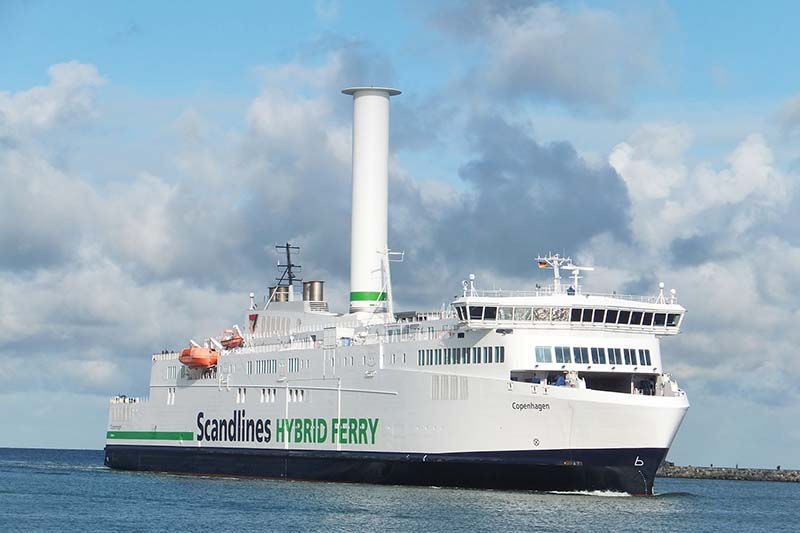
Hybrid ferry named Copenhagen with 30 meter high rotor sail by Norsepower (Scandlines)
Five other ships use Norsepower's rotor sails, including a new iron ore supertanker leased by Brazilian mining giant Vale. The clunky red vessel with 24.4-meter-tall rotating tubes combined is expected to reduce fuel costs and emissions by about 8%, according to Norsepower.
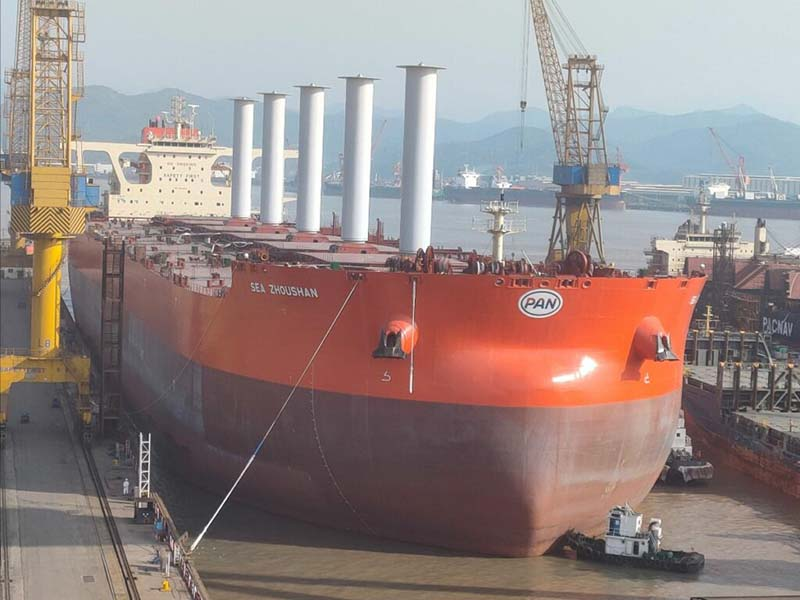
Norsepower's rotor sails fitted to the new-build supertanker (Norsepower)
Winged Sail
While the rotor sail is the most popular wind propulsion device today, other technologies are gradually being commercialized. Paris-based startup Ayro is building four rotating “wing sails” this year, to be installed on the deck of the 122-meter cargo ship Canopée. Once completed, the ship will carry parts of the Ariane 6 rocket launcher from Europe to the French Guiana Space Center.
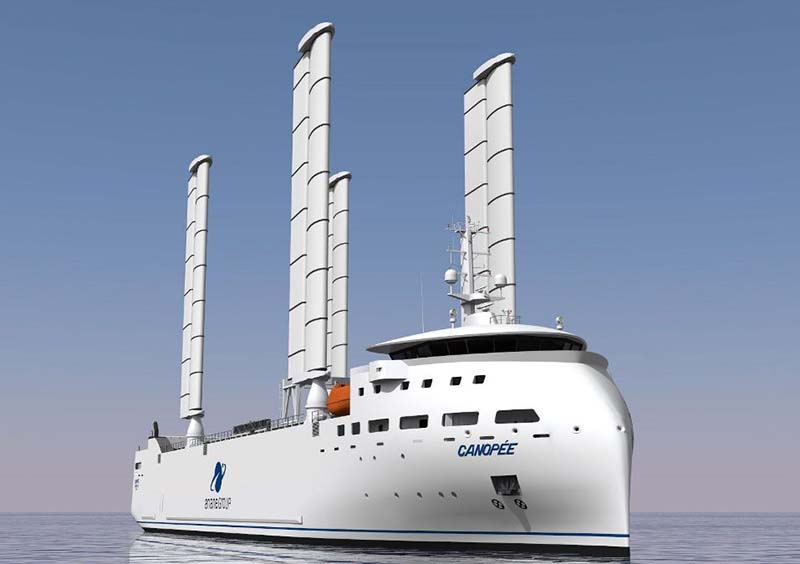
Cargo ship Canopée with four Oceanwing 363 systems (Ayro)
The Ayro Company's Oceanwing 363 system consisted of tall vertical sails, each split into two panels. The panels can rotate 360 degrees, adjust to wind conditions, or fold toward the base when the vessel no longer needs the help of the wind. Sensors and motors automatically adjust the angle of the sail on the ship's voyage.

Ayro's self-rotating Oceanwing (Ayro)
Ayro is a subsidiary of VPLP Shipbuilding, which designed and built the first Oceanwing prototype in 2016. Three years later, a pair of Oceanwings were installed aboard the Energy Observer, which is a two-hull ship. run entirely on renewable energy.
The sails in the upcoming Canopée project will be 10 times larger than those installed on the Energy Observer, about 362 square meters a piece. Ayro raised 10.5 million euros ($11.9 million) in funding last year to start building Oceanwings in northern France.
Blow air to harness the wind
Another modern take on traditional sails is the Michelin inflatable, inflated sail. The French tire maker plans to mount its technology on a merchant vessel for a test run by the end of 2022.
Michelin announced its Wing Sail Mobility project in June 2021. Originally patented by two Swiss inventors, the wing sail is designed to cut through the air like an airplane wing, create lift and propel the ship on water. With the push of a button, the telescopic mast will rise 17 meters high. A small air compressor will inflate the wings on the sides that span about 93 square meters. Both the sail and mast can be automatically retracted when the vessel needs to go under the bridge or prepare to dock.
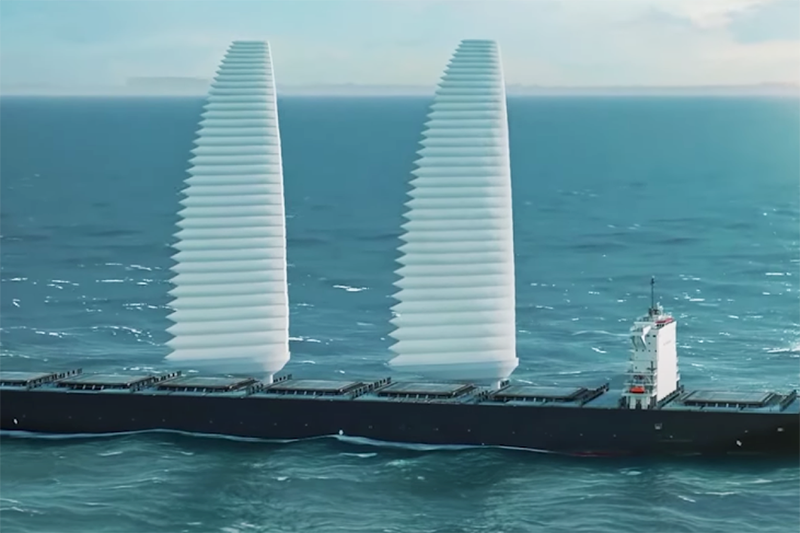
3D drawing of a Michelin wing-sail propulsion system on a cargo ship (Michelin)
Michelin estimates its system can improve a train's fuel efficiency by 20%, depending on the route and weather conditions.
Solutions to cut bills for cleaner fuels in the future
Airseas general secretary Stephanie Lesage said that in addition to helping shipping companies curb the desire to continue using fossil fuels, wind propulsion devices can also help in the process. transition to cleaner alternative fuels. Fuels called "green" ammonia and "green" hydrogen - produced with renewable energy - are expected to cost significantly more than current traditional marine fuels. Reducing a ship's overall fuel needs can help limit some of the price shocks when switching to "green" fuels.
“Wind is an abundant, free source of energy,” said Ms. Lesage, “It will be a very important complement to other disruptive technologies or other alternative fuels when they are ready.” to bring on board.”










